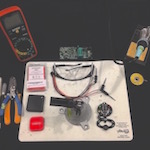DEF CON 26
River Loop had the privilege of presenting our latest efforts in wireless fuzzing, including the TumbleRF software framework and the Orthrus offensive radio interface, at DEF CON 26 in Las Vegas, NV.
This research highlights the importance of securing oft-overlooked system components, such as non-IP network interfaces and hardware buses. 2014’s Isotope 802.15.4 bugs highlighted an interesting class of vulnerability existing at the PHY layer, so we wrote some tools to make uncovering bugs like those more systematic.






